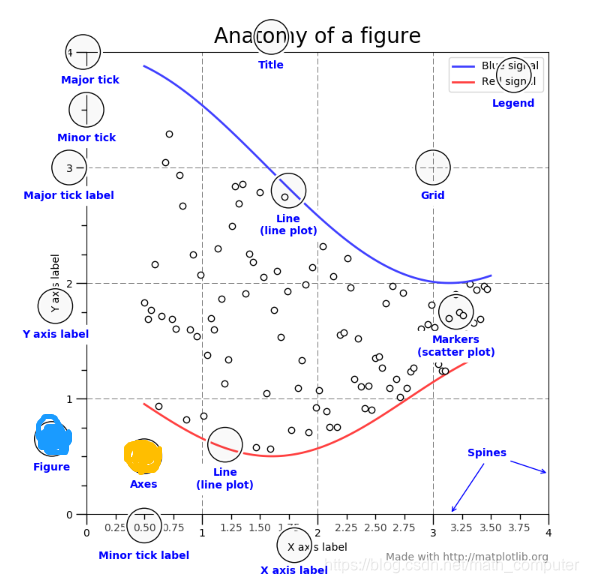anuário
referência
- Principalmente consulte a documentação oficial
- Ele falou sobre o "ambiente estado-máquina", para me ajudar a entender esse conceito
níveis
Superlativo: o matplotlib "ambiente estado-máquina". Veja os exemplos abaixo, a utilização de toda a função módulo plt de fazer as coisas, não use métodos e propriedades do objeto.
import matplotlib.pyplot as plt
plt.figure(1) # the first figure
plt.subplot(211) # the first subplot in the first figure
plt.plot([1, 2, 3])
plt.subplot(212) # the second subplot in the first figure
plt.plot([4, 5, 6])
plt.figure(2) # a second figure
plt.plot([4, 5, 6]) # creates a subplot(111) by default
plt.figure(1) # figure 1 current; subplot(212) still current
plt.subplot(211) # make subplot(211) in figure1 current
plt.title('Easy as 1, 2, 3') # subplot 211 title
plt.show()
Um secundário: uma primeira camada de interface orientada por objectos. Neste ponto, o módulo de função plt só é usado para criar uma figura, eixos e outros objetos, e, em seguida, fazer as coisas diretamente com o objeto interface.
x = np.arange(0, 10, 0.2)
y = np.sin(x)
fig, ax = plt.subplots()
ax.plot(x, y) # 使用ax的方法做事情
plt.show()
objetos

figura
Figura compreende uma pluralidade de eixos, que não pode ser um
- figura múltipla, eixos
import matplotlib.pyplot as plt
plt.figure(1) # the first figure
plt.subplot(211) # the first subplot in the first figure
plt.plot([1, 2, 3])
plt.subplot(212) # the second subplot in the first figure
plt.plot([4, 5, 6])
plt.figure(2) # a second figure
plt.plot([4, 5, 6]) # creates a subplot(111) by default
plt.figure(1) # figure 1 current; subplot(212) still current
plt.subplot(211) # make subplot(211) in figure1 current
plt.title('Easy as 1, 2, 3') # subplot 211 title
plt.show()
- Uma figura, não há eixos
fig = plt.figure() # an empty figure with no axes
fig.suptitle('No axes on this figure') # Add a title so we know which it is
# plt.plot([1,2,3]) # draw a line (now have an axes)
# plt.show() # show the plot
machados
Um membro do alvo tem uma pluralidade de eixos objetos eixo (trama 2D há dois, são eixos x e y; trama 3D tem três)
import matplotlib.pyplot as plt
x = np.arange(0, 10, 0.2)
y = np.sin(x)
fig, ax = plt.subplots()
fig.suptitle("basic math")
ax.plot(x, y, label='sin') # 使用ax的方法做事情
ax.set_title('sin function')
ax.set_xlabel('x')
ax.set_ylabel('y')
ax.set_xlim(-1, 11)
ax.legend()
plt.show()
dados
De um modo preferido dados np.array, paládio, e pode ser np.matrix seguinte conversão
a = pandas.DataFrame(np.random.rand(4,5), columns = list('abcde'))
a_asarray = a.values
b = np.matrix([[1,2],[3,4]])
b_asarray = np.asarray(b)
mpl, plt e Pylab
matplotlib é um pacote, pyplot é um módulo sob matplotlib, pyplot recolha Pylab e Numpy formar um espaço de nomes unificado (preterido é).
Para plt, a função da qual não é sempre um número actual e os eixos correntes (criado automaticamente)
x = np.linspace(0, 2, 100)
plt.plot(x, x, label='linear')
plt.plot(x, x**2, label='quadratic')
plt.plot(x, x**3, label='cubic')
plt.xlabel('x label')
plt.ylabel('y label')
plt.title("Simple Plot")
plt.legend()
plt.show()
estilo de código
- Np plt e reutilização explicitamente importação, nem todos os objetos introduzidos nele, para evitar a contaminação namespace
- Uso plt criar eixos e a Figura objectos, e, em seguida, utilizar um método de controlo objecto adicional
- Np fazer uso de dados
- imagem de exibição Use plt
# 导入方式
import matplotlib.pyplot as plt
import numpy as np
def my_plotter(ax, data1, data2, param_dict):
"""
A helper function to make a graph
Parameters
----------
ax : Axes
The axes to draw to
data1 : array
The x data
data2 : array
The y data
param_dict : dict
Dictionary of kwargs to pass to ax.plot
Returns
-------
out : list
list of artists added
"""
out = ax.plot(data1, data2, **param_dict) # 使用对象操作
return out
# which you would then use as:
data1, data2, data3, data4 = np.random.randn(4, 100) # 数据
fig, (ax1, ax2) = plt.subplots(1, 2) # 获取figure和axes对象
my_plotter(ax1, data1, data2, {'marker': 'x'})
my_plotter(ax2, data3, data4, {'marker': 'o'})
plt.show()
backend
Interativo e não-interativo back-end back-end
Especifique o backend
- backend arquivo de parâmetros matplotlibrc (meu computador, este arquivo está localizado em
C: \ Users \ xxxx \ PycharmProjects \ untitled1 \ venv \ Lib \ site-packages \ matplotlib \ sob mpl-dados)

- Especificado no roteiro
import matplotlib
matplotlib.use('PS') # generate postscript output by default
Neste ponto, se houver roteiro plt.show () não exibir as imagens, e será UserWarning relatou:

- variável ambiente (que não há exemplos específicos)
considerações sobre o desempenho
O principal simplificação é o render, que compreende uma linha, marca, etc, pode ser usado como modo rápido, simples
import matplotlib.style as mplstyle
mplstyle.use('fast')
